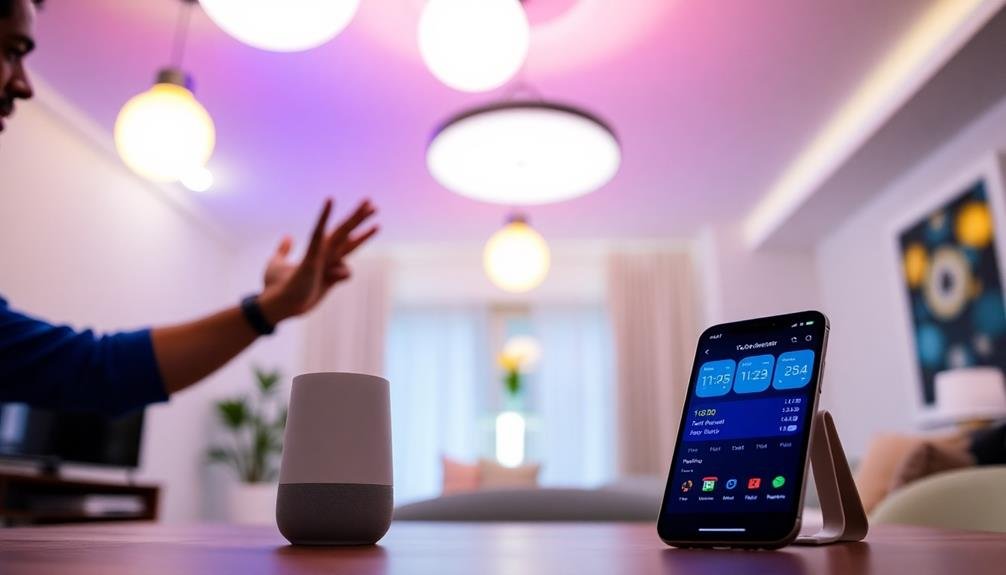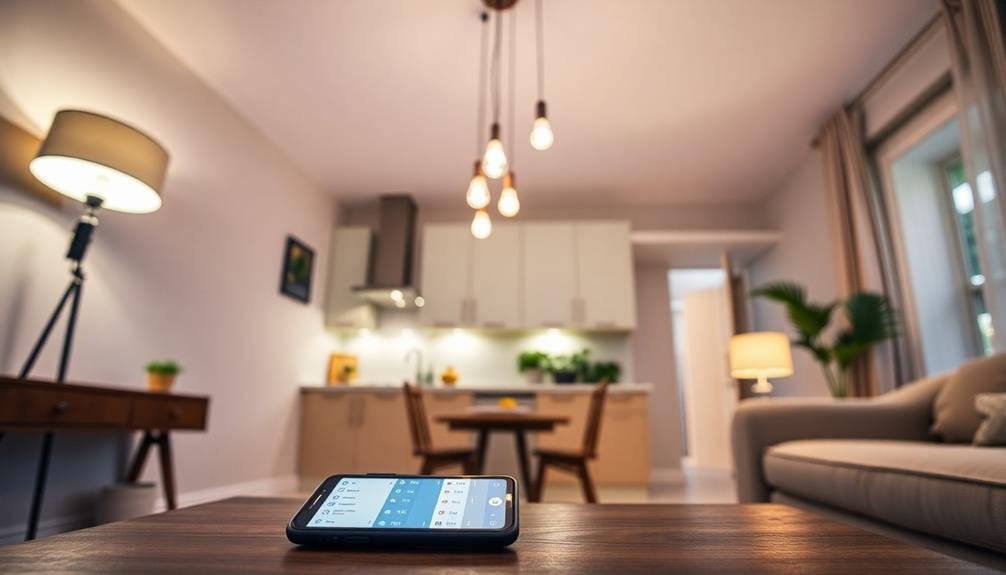Boost your home's efficiency with these three clever LED bulb scheduling hacks. First, set up timed routines to automatically adjust lighting based on your daily schedule and seasonal changes, reducing energy waste. Second, implement geofencing to create a virtual boundary that triggers your lights when you enter or leave home, ensuring maximum convenience and savings. Third, integrate voice commands with your smart home system to easily control and override schedules on the fly. These techniques not only streamline your lighting but also enhance security and comfort. Explore these smart lighting strategies to transform your home into an energy-efficient haven.
Timed Routines for Energy Savings

Smart homeowners know that timed routines for LED bulbs can lead to significant energy savings. By scheduling your lights to turn on and off automatically, you'll avoid wasting electricity when illumination isn't necessary.
Start by identifying high-traffic areas in your home and setting up daily routines. Program your living room lights to switch on just before you arrive home from work and turn off at bedtime. In hallways and staircases, use motion sensors to activate lights only when needed.
For outdoor lighting, create schedules that align with sunset and sunrise times, adjusting seasonally. You can also implement dimming routines, gradually decreasing brightness as the evening progresses. This not only saves energy but also helps prepare your body for sleep.
In rarely used spaces like guest rooms or storage areas, set lights to turn on briefly each day to deter intruders and check for any issues.
Don't forget to account for weekends and holidays in your schedules. Many smart LED systems allow you to create different routines for various days of the week.
Geofencing for Automated Control
Geofencing technology takes LED bulb automation to the next level. By creating a virtual boundary around your home, you can trigger your LED lights to turn on or off based on your location. This smart feature guarantees your lights are only on when you need them, saving energy and adding convenience to your daily routine.
To set up geofencing, you'll need a smart home hub or a compatible LED bulb system with a mobile app. Once configured, your lights can automatically adjust as you enter or leave the designated area. Here's a quick comparison of popular geofencing-enabled LED systems:
| System | Range | Customization |
|---|---|---|
| Philips Hue | 100m | High |
| LIFX | 200m | Medium |
| Sengled | 150m | Low |
You can further customize your geofencing setup by creating multiple zones or combining it with other automation rules. For example, you might set your lights to turn on only if you arrive home after sunset or to gradually dim as you approach bedtime. With geofencing, you'll never have to worry about forgetting to turn off the lights when you leave, and you'll always return to a well-lit home.
Voice Command Scheduling Integration

With the rise of smart speakers and voice assistants, integrating voice commands into your LED bulb scheduling has become easier than ever. You can now control your lighting schedule hands-free, making adjustments on the fly without reaching for your smartphone or tablet.
To get started, verify your smart LED bulbs are compatible with your voice assistant of choice, such as Amazon Alexa, Google Assistant, or Apple's Siri. Once connected, you can create custom voice commands to set schedules, adjust brightness, or change colors. For example, you might say, "Alexa, turn on the living room lights at sunset every day" or "Hey Google, dim the bedroom lights at 10 PM."
You can also use voice commands to create more complex schedules. Try setting up routines that combine multiple actions, like "Good morning" to gradually brighten your lights, raise the blinds, and start your coffee maker.
For added convenience, use voice commands to override existing schedules temporarily without disrupting your regular routine. This flexibility allows you to adapt your lighting to unexpected changes in your schedule or mood, all without lifting a finger.
Frequently Asked Questions
Can LED Bulbs Be Dimmed With Smartphone Apps?
Yes, you can dim LED bulbs using smartphone apps. Many smart LED bulbs connect to your home's Wi-Fi network, allowing you to control brightness levels through dedicated apps. You'll need compatible smart bulbs and a stable internet connection.
Are There LED Bulbs That Change Color Based on Time?
Yes, you'll find smart LED bulbs that change color based on time. You can program them to shift hues throughout the day using smartphone apps. They'll automatically adjust colors to match your schedule or preferred ambiance at different hours.
How Do Smart LED Bulbs Affect Home Wi-Fi Performance?
Smart LED bulbs can impact your home Wi-Fi performance. They'll use bandwidth and may cause network congestion, especially if you have many connected devices. You might notice slower speeds or connectivity issues if your network isn't robust enough to handle them.
Can LED Bulbs Be Scheduled to Mimic Occupancy When Away?
Yes, you can schedule LED bulbs to mimic occupancy when you're away. You'll need smart bulbs connected to a home automation system. Set up varying on/off patterns for different rooms to create a realistic impression of someone being home.
Are There LED Bulbs That Sync With Music or TV?
Yes, you'll find LED bulbs that sync with music or TV. They use built-in microphones or connect to your devices via Wi-Fi or Bluetooth. You can enjoy a dynamic light show that pulses and changes colors with your entertainment.
In Summary
You've now got three smart ways to take control of your LED bulbs. By setting up timed routines, using geofencing, and integrating voice commands, you'll save energy and enjoy effortless lighting control. Don't be afraid to experiment with these hacks to find what works best for your home. With a bit of creativity, you'll transform your living space into a more efficient, comfortable, and tech-savvy environment. Embrace these tricks and watch your home lighting evolve.





Leave a Reply